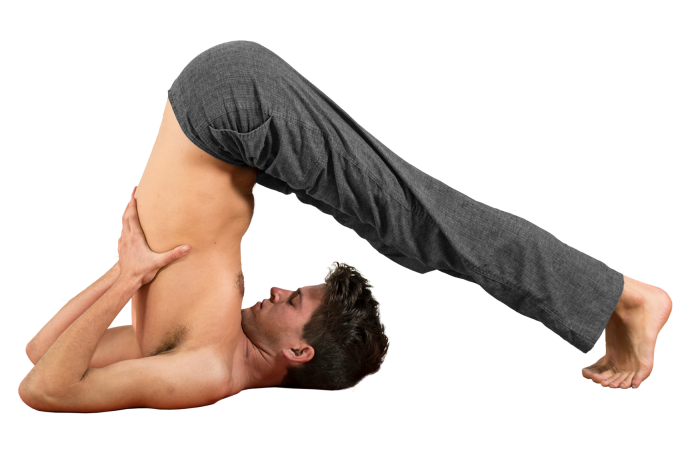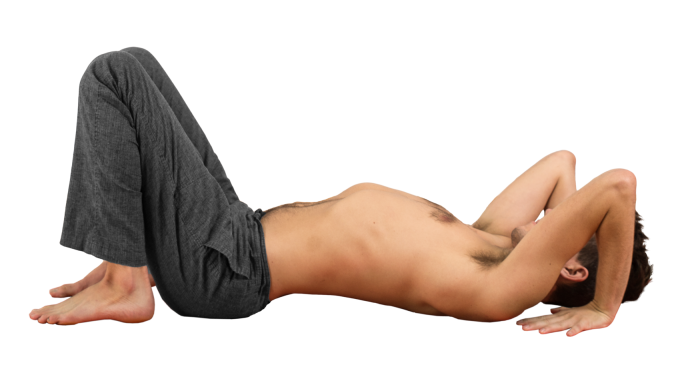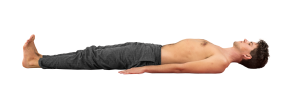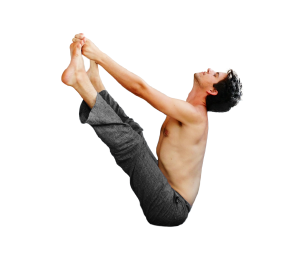- Baddha: Bound
- Kona: Angle
- Asana: Pose
Baddha Konasana is the twenty-fourth pose of the primary series, and the nineteenth seated pose. It has three forms: upright, folded, and flexed.
In this asana, the feet press together and the knees press towards or into the ground.
FOCUS ON…
The prime focus as you begin working in this pose is to anteriorly tilt the pelvis. This action can be overdone if you’re hypermobile, but the vast majority of practitioners experience a posteriorly tilted pelvis in this asana. (For more on pelvic tilt, read: Understanding Pelvic Tilt.) The movement of the knees towards the ground—the lengthening of the adductors and groin musculature—ought to be secondary to establishing a firm, upright position. ‘A’ Variation is the place to work on bringing the knees towards the ground; ‘B’ & ‘C’ emphasize the the full range of motion of the pelvis, and the knees reaching the earth is of lesser concern.
In the first form of this pose, the spine should be in a neutral position. In the second form, the spine is in slight flexion. In the third form, the spine is in deep flexion and the pelvis posteriorly rotated.
Even if, especially if, you’re very stiff, kyphotic, and posteriorly rotated, be sure that you’re making the effort of anterior tilt, even though actual movement may be slight.
In all variations, the prime action of the legs is one of external rotation, rather than simply pressing straight down. The sensation is that of rolling the thighs back, towards the sacrum. You can use your hands to help at first, if that action is hard to find. Between variations, allow the hips to move freely; the legs will naturally alternate between the actions of internal and external rotation as you move.
‘A’ Variation
In the first form, Baddha Konasana A, the knees close fully, the feet come to touch, and the hands grasp the feet. Bring the heels as close to the hips as possible. For the knees to come to the ground, the heels will need to be no more than a couple of inches from the pelvis. Do not try and push your knees to the ground, or have someone else push your knees to the ground, if the feet are farther away. That will generate a twisting force in the knee, which is asking for injury.
Therefore, if your feet do not touch your pelvis: focus just as much on, over time, bringing the feet closer to the body as you do on moving the knees towards the ground.
The hands turn the soles of the feet upwards. This is done in order to (1) activate the lateral hip muscles, which will help bring the knees towards the earth, and (2) further isolate and lengthen the inner thigh muscles. This action is done in all 3 forms. The hands and arms also tug gently on the feet, pulling the heart through the arms; in this way, encouraging the heart to lift upright and the practitioner to retain an upright and noble carriage rather than slouching or slumping.
As in other forward folds, the line of the collarbones should be lengthened, and the shoulders back (until they reach a neutral position: no pinching the shoulder blades together).
‘B’ Variation
Following from the A variation, maintain all actions except:
- Space the feet 4-6 inches from the pelvis (allow the knees to come off the floor, if they were touching). If the feet aren’t distanced in this way, the sitting bones can lift off the ground when you fold forward.
- Fold forward as much as the body allows without slumping. That may be only a slight movement of several inches, or to such a degree as the ribs touch the feet. Do not strive beyond your flexibility; aggressively trying to reach your head to the ground and sacrificing the necessary alignments of the spine and hips will work to your disadvantage. If you’re quite flexible, the chin touches the ground.
- Rather than focusing on head-to-ground, focus on bringing the heart forward so that the sternum touches the knees.
‘C’ Variation
Following from the B variation, sit upright, rock the pelvis into a posterior tilt, round the back deeply, and tug on the feet: fold the forehead towards or to touch the toes.
Vinyasa of the Pose
From Sat, jump through and land in Dandasana.
Inhale, bend the knees into the chest, press the feet together and open the knees wide. Press the pinky edges of the feet together; sit upright; gaze down the length of the nose. Stay here for five breaths; this is the state of Baddha Konasana ‘A.’


Exhale, nudge the feet out a few inches if they’re quite close the pelvis, then fold forward. Only fold as much as you can with a straight spine. Stay here for five breaths; this is the state of Baddha Konasana ‘B.’ Maintain the intelligent action of the legs in external rotation.

Inhale and sit upright. Round your back, starting at the pelvis. Take the time to flex each part of the spine fully.
Exhale, fold forward and reach your head towards your toes. Stay here for five breaths; this is the state of Baddha Konasana ‘c.’

Inhale, sit upright. Hug the knees into the chest.
Exhale, take vinyasa.
ALTERNATIVES & SOLUTIONS
If you’re feeling stiff, and/or the pelvis will not tip forward while you’re sitting on the ground, seat yourself on a blanket, block, or bolster, in order to elevate the hips. This will help you bring your feet in closer. Be sure that you sit towards the front edge of your chosen support, such that you’re able to cultivate a sense of tipping forward rather than rolling back. Over time, take this sense, and the forward direction of movement, to a seat on the floor.
If sitting upright in ‘A’ variation is challenging, do not practice ‘B’ until it seems both comfortable and necessary to do so. ‘C’ variation is still appropriate.
If you have had knee injury or surgery, and/or feel a pinching sensation when the knee is closed fully in this way, place a rolled up washcloth or piece of fabric behind the knee. When you squeeze the cloth with your knee, the bones of the femur and tibia will be held slightly apart. In the majority of cases, this alleviates or eliminates any pinching sensation or pain. The more severe the injury, the greater amount of cloth should be used. The support can be reduced over time as the joint heals. It’s also helpful when recovering from a knee injury to sit up higher using blankets.
If your knees don’t touch the ground, you might find it helpful to place a block beneath each leg so you can find the sensation of pressing down through the legs and the activation of the outer hip muscles. This is neuro-educational only; do not become reliant.
COMMON MISTAKES
Avoid slouching or hunching forward.
Do not press your knees to the ground if the feet are not within 2-3 inches of the pelvis.


































